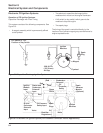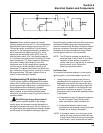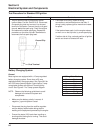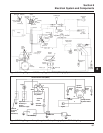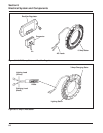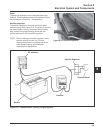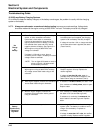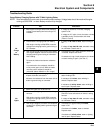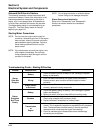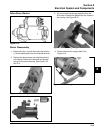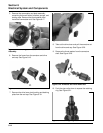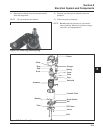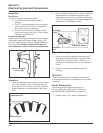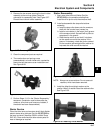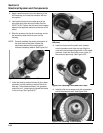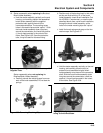
8.12
Section 8
Electrical System and Components
Solenoid Shift Electric Starters
The following subsection covers the solenoid shift
style electric starters. Some of the information in the
preceding subsection relates also to this style of
starter, so it is not repeated here. A Nippendenso
or Delco-Remy solenoid shift starter may be used.
The Nippendenso starter is covered beginning on
Page 8.21. The Delco Remy starter is covered
beginning on page 8.13.
Starting Motor Precautions
NOTE: Do not crank the engine continuously for
more than 10 seconds at a time. If the engine
does not start, allow a 60 second cool-down
period between starting attempts. Failure to
follow these guidelines can burn out the
starter motor.
NOTE: If the starter does not crank the engine, shut
off the starter immediately. Do not make
further attempts to start the engine until the
condition is corrected.
NOTE: Do not drop the starter or strike the starter
frame. Doing so can damage the starter.
Starter Removal and Installation
Refer to the “Disassembly” and “Reassembly”
Sections for starter removal and installation
procedures.
Troubleshooting Guide – Starting Difficulties
Problem
Starter
Energizes
But Turns
Slowly
Possible Fault
Battery
Wiring
Starter Switch
or Solenoid
Battery
Brushes
Transmission
or
Engine
Correction
1. Check the specific gravity of battery. If low, recharge or replace
battery as necessary.
1. Clean corroded connections and tighten loose connections.
2. Replace wires in poor condition and with frayed or broken
insulation.
1. Bypass the switch or solenoid with a jumper wire. If starter cranks
normally, replace the faulty component.
1. Check the specific gravity of battery. If low, recharge or replace
battery as necessary.
2. Battery too small, must be at least 400 cold cranking amps.
1. Check for excessively dirty or worn brushes and commutator.
Clean using a coarse cloth (not emery cloth).
2. Replace brushes if excessively or unevenly worn.
1. Make sure the clutch or transmission is disengaged or placed in
neutral. This is especially important on equipment with hydrostatic
drive. The transmission must be exactly in neutral to prevent
resistance which could keep the engine from starting.
2. Check for seized engine components such as the bearings,
connecting rod, and piston.
Starter
Does Not
Energize



